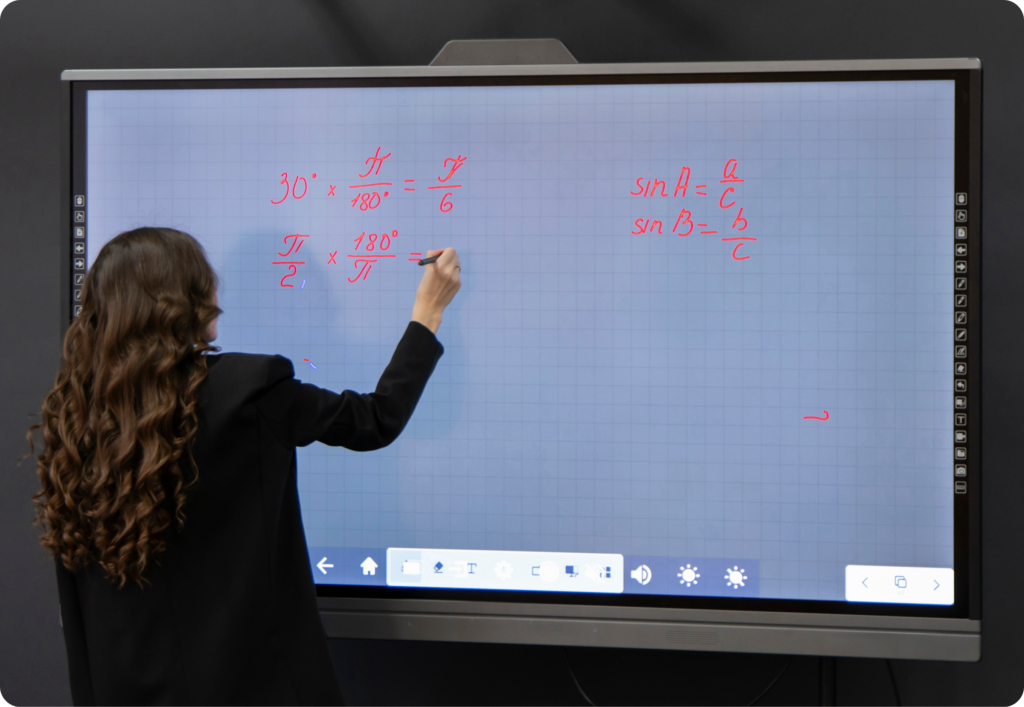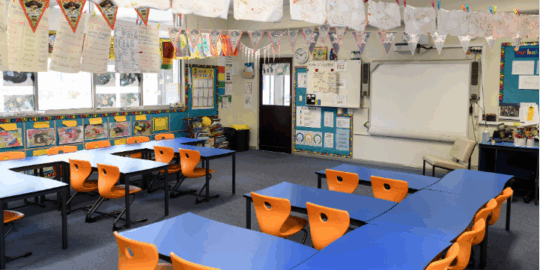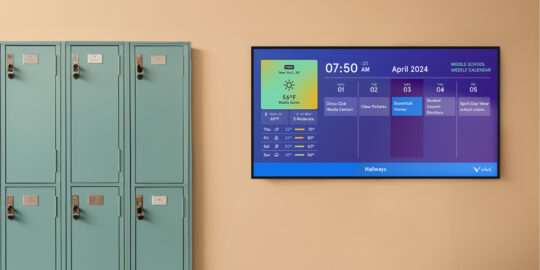
Is your school district upgrading or refreshing its classroom displays? You have more options than you might realize. Implementing new technology often requires extensive training and adaptation, leading to increased help-desk tickets and educator frustration. A simpler, more compatible alternative could save your district time, money, and inconvenience.
In the modern classroom, technology not only introduces new teaching methods but also boosts engagement and collaboration. However, the complexity and cost of traditional interactive flat panels (IFPs) can be daunting. This blog will explore the common issues with IFPs in schools, explore cost-effective alternatives, and share success stories demonstrating how these solutions enhance educational environments.
The challenge with traditional IFPs
Envision a classroom filled with excitement for new technology, only to discover that integrating IFPs isn’t as seamless as expected. The reality often includes extensive training sessions that consume valuable teaching time and compatibility issues that hinder the intended innovation. The result? Frustrated teachers, confused students, and a tech team scrambling to keep up. Here are some common problems with IFPs in schools.
1. Compatibility and integration hurdles
Traditional flat panels often lock schools into a specific ecosystem, complicating integration with devices running different operating systems. This limitation not only impacts the flexibility in teaching but also adds to the cost when additional components need compatibility.
2. Training and usability roadblocks
The appeal of IFPs comes with a significant caveat: they demand continuous, often complex, training. Teachers must become adept not just at using the technology, but at troubleshooting on the fly—an expectation that can lead to anxiety rather than excitement about new tools.
3. Fragility and maintenance costs
A frequent concern among educators is the fragility of IFPs. Teachers report that students can be rough with the equipment, leading to damage that is expensive and time-consuming to repair. The expense and loss of access that come with fixing broken panels pose significant disruptions to classroom activities, emphasizing the need for more durable and maintenance-friendly solutions.
4. Data limitations and analytical gaps
Most IFPs do not capture usage data effectively, making it challenging to assess how frequently and in what ways they are utilized within the classroom setting. The lack of detailed data hampers efforts to optimize technology use and to justify the investment in these systems, highlighting a gap in analytics that more advanced solutions could fill.
5. Mobility limitations for teachers
IFPs often confine teachers to the front of the classroom due to their fixed installation. This restriction limits direct interaction with students and reduces the teacher’s ability to manage and engage the classroom dynamically. The static positioning of these panels highlights the need for more mobile and adaptable teaching solutions to foster a more inclusive and interactive learning environment.

Teacher tethered to the front of the classroom using an IFP, emphasizing a conventional approach.
Exploring alternatives to IFPs
Given these challenges, many schools are turning to more adaptive and flexible technologies. One such solution is Vivi. Explore the success stories below to see how Vivi is being effectively utilized in classrooms.
Classroom tech for better learning
Vivi’s technology is designed to empower educational environments, enhancing academic success and improving classroom interaction. It addresses the challenges posed by traditional setups, streamlining the integration of tech to enhance both teaching and learning.
Enhancing classroom technology
Traditional IFPs often require extensive training and troubleshooting, creating roadblocks instead of opportunities for seamless learning. Vivi simplifies these challenges by providing a user-friendly, reliable, and device-agnostic solution that integrates easily into any educational environment.
Simplified setup and use
One of Vivi’s standout features is its reputation as an easy-to-use classroom technology system, requiring minimal setup. Howard Carlin, Executive Director of Technology for Forney ISD in Texas, emphasizes, “Vivi is not just a cost-effective alternative to interactive flat panels; it’s even better. It enables that mobility. It is device-agnostic. If you build your network right and install it right, anyone can walk in and plug and play in a room. No adapters. No cables. Just, oh, it’s a new room with a different room name.”
Reliability and consistency
Forney ISD’s adoption of Vivi showcases its reliability and consistency. The district standardized its AV setup across all classrooms, ensuring a uniform experience for teachers and students. This approach eliminated the need for frequent troubleshooting and minimized technical issues, providing a stable and dependable technology environment.
Improved management and cost-effectiveness
Vivi’s technology is designed to empower educational environments, enhancing academic success and invigorating classroom interaction. It directly addresses the challenges posed by traditional setups, streamlining the integration of tech to enhance both teaching and learning.
Unlocking Classroom Mobility
New Providence Elementary Schools in New Jersey encountered similar issues with traditional IFPs. By implementing Vivi, the schools adopted a solution that offers enhanced flexibility and mobility in the classroom. Julie Spoer, the Elementary Technology Coordinator expressed the limitation this posed, “Before Vivi, we had desktops in every classroom that were tethered to either the interactive board or the interactive projector, and so teachers had to stand at that one spot.”
Freedom from cabled tech setups
With Vivi, New Providence Elementary Schools moved away from traditional cabled tech setups. Teachers now navigate the classroom freely, engaging directly with students rather than being anchored to a computer or main display.
Wireless screen mirroring
Vivi’s wireless screen mirroring technology has transformed classrooms at New Providence into dynamic learning environments. Teachers can share content effortlessly from anywhere in the room, enhancing both classroom management and student engagement.
Reducing strain on educators
The shift to adaptive and less restrictive technologies like Vivi has reduced the strain on educators and tech teams at New Providence, making educational technology more effective and manageable.

Teacher moves freely around the classroom, engaging with students without being tied to the front, thanks to Vivi.
Reducing educational technology costs
Switching to Vivi offers substantial cost benefits compared to traditional interactive flat panels. These alternatives streamline technology integration and significantly lower both initial and ongoing expenses.
Our technology requires minimal setup and integrates seamlessly with existing devices, cutting down on initial costs and ongoing maintenance. This plug-and-play capability reduces the need for extensive IT support and frequent professional development, leading to operational savings.
Leveraging existing infrastructure
By utilizing current classroom displays such as flat panel TVs or non-interactive projectors, Vivi eliminates the need for costly new hardware. This adaptability extends the lifecycle of existing equipment and minimizes future expenditure on upgrades.
Analyze with our total cost of ownership calculator
For a detailed understanding of potential savings, our Total Cost of Ownership Calculator offers a personalized analysis. Schools can input their specific data to see a comparative financial overview between Vivi’s solutions and traditional panels.
Choosing the right technology for classrooms
Adopting Vivi simplifies integration, reduces costs, and enhances engagement and safety. Unlike traditional IFPs, Vivi is flexible, user-friendly, and cost-effective.
Success stories from Forney ISD and New Providence Elementary Schools demonstrate how Vivi enhances classroom dynamics, creating more interactive, collaborative, and secure learning environments.
See the difference Vivi can make in your classrooms today. Book a demo today!



